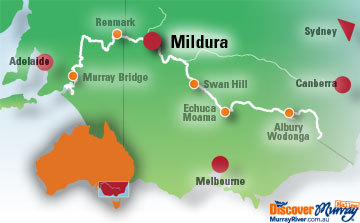
Mildura Riverfront Shared Path - Water Quality
Water is essential to human life and the health of the environment. Water has two dimensions that are closely linked: quantity and quality. Water quality is commonly defined by its physical, chemical, biological and aesthetic (appearance and smell) characteristics. A healthy environment is one in which the water quality supports a rich and varied community of organisms and protects public health.
Biodiversity is the variety of all life forms - the different plants, animals and micro-organisms, the genes they contain, and the ecosystems of which they form a part.
Good water quality is essential for maintaining biodiversity values. It provides drinkable water for animals, and habitat for water plants and animals. Poor water quality can lead to reduced habitat and food resources for many animals, and therefore reduced biodiversity.
Good water quality is also considered a social and recreational asset. Water based recreation activities such as canoeing, swimming and water-skiing are enjoyed where water quality is good. Poor water quality can discourage these activities and lower enjoyment of the river environment. Potentially toxic blue-green algal blooms can result in un-drinkable water for humans and have major repercussions for recreation and tourism.
How is water quality measured?
The presence of contaminants and the characteristics of water are used to indicate the quality of water. These water quality indicators can be categorised as:
- Biological: bacteria, algae, biological oxygen demand
- Physical: temperature, turbidity, colour, suspended solids, dissolved solids
- Chemical: pH, dissolved oxygen, salinity, nutrients (including nitrogen and phosphorus), organic and inorganic compounds (including toxicants)
- Aesthetic: odours, taints, colour, floating matter
These indicators can be used to measure changes in water quality and determine whether it is suitable for the health of the natural environment and the uses for which the water is required. Water quality information can then be used to develop management programs and action plans to ensure that water quality is protected.
What affects the quality of our water?
Water quality is closely linked to the surrounding environment and land use. It is affected by community uses such as agriculture, urban and industrial use and recreation. The modification of natural stream flows by dams and weirs can also affect water quality. The weather, too, can have a major impact on water quality, particularly in a dry country like Australia which is periodically affected by droughts.
The riverfront reserves function as a buffer between adjoining land-based activities and the river. As a buffer they have the capacity to absorb impacts
from land-based activities, such as sediment loads from erosion.
Did you know?
97% of the world’s water is seawater, only 3% is fresh water and only 1% is drinkable
Case Study
Carp - Introduced Pest
The Carp is a medium sized introduced fish species with a forked tail. It reaches a maximum of 1200mm and 60kg, but is usually up to 4–5kg. It has thick fleshy lips and two pairs of ‘whiskers’ at the corners. The scales are large and thick.
The Carp is usually associated with warm, slow-flowing lowland rivers or lakes. It is tolerant of a wide range of environmental conditions and able to survive extremely low levels of dissolved oxygen.
Carp feed by sucking in sediment, sorting the edible items from the inedible sediment, and expelling the sediment through the gill openings. Feeding this way increases turbidity levels in waterways and erodes the riverbank causing a decline in water quality. Their high abundance in many streams and lakes means they are also competing with native fish for food and space.
Did you know?
Carp eggs only take 2-6 days to hatch
More on Pest Plants and Animals
Pest plants and animals are a significant threat to the health of native riparian vegetation, biodiversity and water quality. Pest plants and animals can threaten biodiversity by out-competing native species and reducing the quality and extent of habitat for native animals.
Pest plants include invasive garden plants. Garden plants can be spread to natural areas by the dumping of garden waste and seeds and fragments being carried in by vehicles, bicycles and on shoes. Pest plants can also affect social and recreational values by changing the character of the river frontages and affecting aesthetic values. Priority weeds for eradication in the Mallee region that are known to occur through the riverfront reserves are African Boxthorn, Bridal Creeper, and Prickly Pear.
Pest animals that threaten the values of the riverfront reserves include rabbits, the red fox, feral cats, feral pigs, feral goats and carp. Impacts from these include: erosion of soils, erosion of river banks, direct predation on native animals, competition with native animals for resources and grazing on native vegetation including the prevention of regeneration.
Mildura Riverfront Shared Path
Published with permission of Mildura Rural City Council
Tell your friends you found this at murrayriver.com.au!
Copyright Discover Murray 2025. This site or any portion of this site must not be reproduced, duplicated, copied, sold, resold, or otherwise exploited for any commercial purpose that is not expressly permitted by DISCOVER MURRAY.






 Amy Shark The Solo Acoustic "Songs & Stories" Tour
Amy Shark The Solo Acoustic "Songs & Stories" Tour Kevin Bloody Wilson Aussie Icon Tour with special guest Jenny Talia
Kevin Bloody Wilson Aussie Icon Tour with special guest Jenny Talia Little By Little
Little By Little The Australian Beach Boys Show
The Australian Beach Boys Show Lee Kernaghan Boys From The Bush The Concert
Lee Kernaghan Boys From The Bush The Concert

